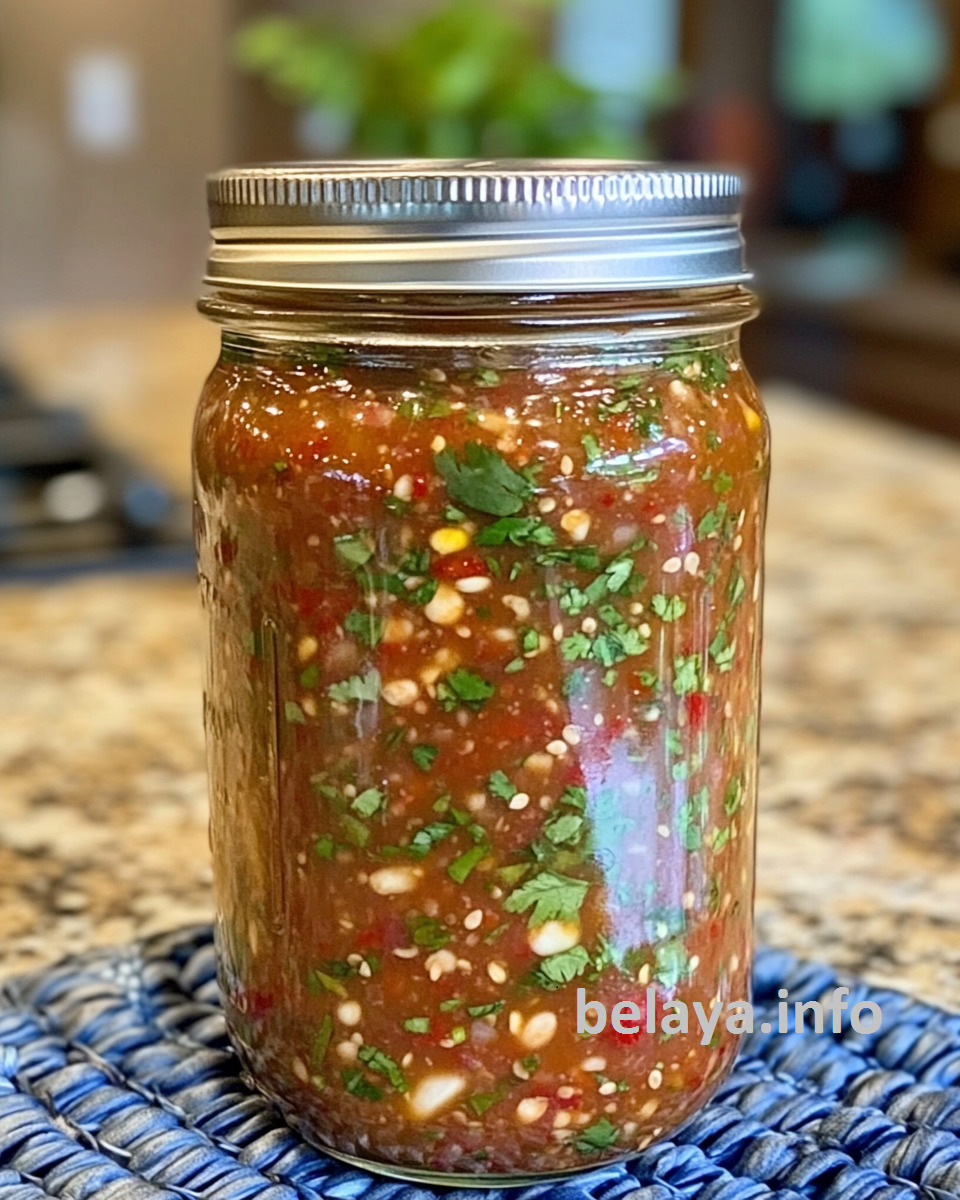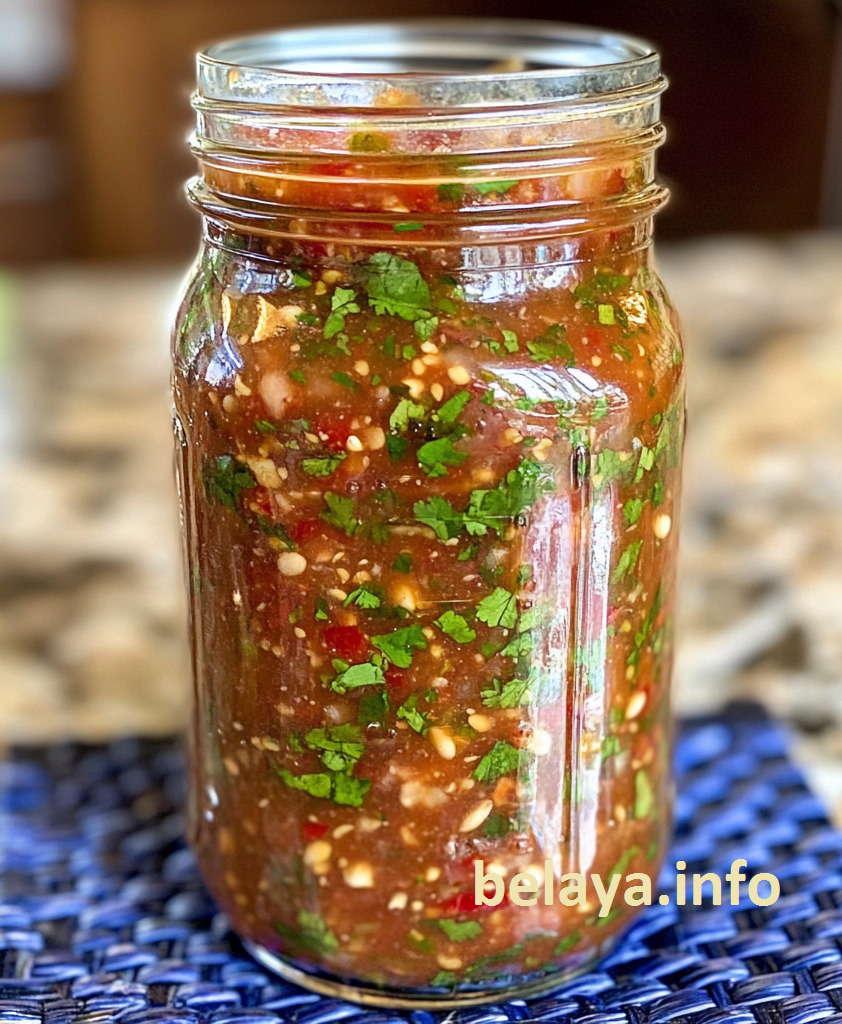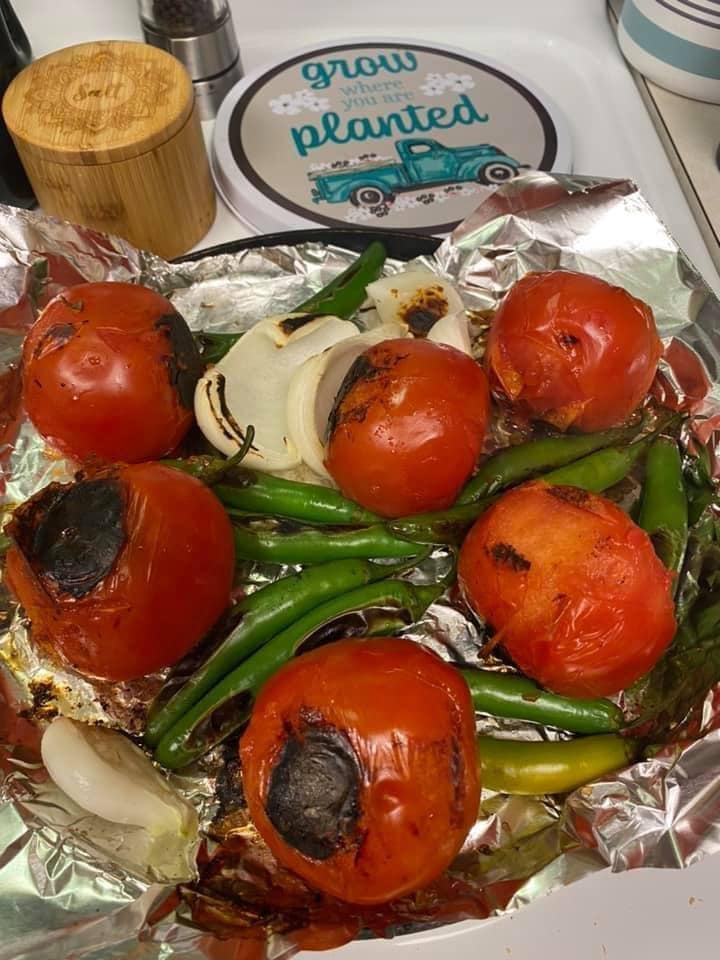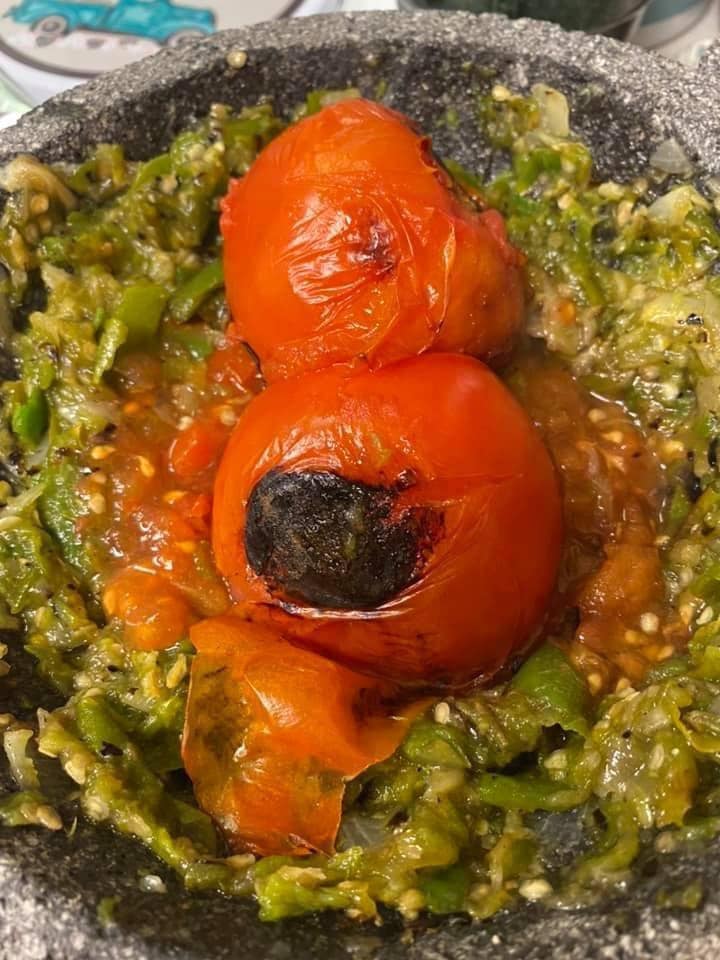Salsa De Molcajete Picosa
Salsa De Molcajete Picosa, or spicy molcajete salsa, is a vibrant and traditional Mexican condiment known for its bold flavors and fiery kick. Made with a variety of fresh chilies, tomatoes, garlic, and onion, this salsa captures the essence of authentic Mexican cuisine.
The ingredients are charred to perfection to enhance their natural sweetness and depth of flavor, then ground in a molcajete (traditional Mexican mortar and pestle) to achieve a rustic texture that elevates any dish.
Whether enjoyed as a dip with tortilla chips or paired with tacos, this homemade salsa promises to add a zesty punch to your culinary creations.

Why You’ll Love This Recipe
Authentic, Fire-Roasted Flavor: Roasting the ingredients imparts a deep, smoky char that brings out the natural sweetness in the tomatoes and intensifies the heat and aroma of the chiles.
Bold, Layered Heat: With a combination of serranos, jalapeños, and chile manzano, this salsa delivers a dynamic range of heat—from sharp and spicy to slow and smoky—that chile lovers will crave.
Textural Authenticity: When prepared in a molcajete, the salsa retains a rustic, stone-ground texture that makes every bite feel handcrafted and traditional, far from store-bought smoothness.
Pure, Whole Ingredients: Made with only fresh vegetables, garlic, and salt—no preservatives or fillers—this salsa is clean, vibrant, and rooted in simplicity.
Deep Cultural Connection: The process of using a molcajete is not just functional—it’s cultural. It evokes generations of Mexican culinary tradition, offering a true taste of heritage in every scoop.
Highly Versatile: Whether spooned over tacos, grilled meats, tamales, or even eggs, this salsa adds instant character and spice to a wide range of dishes.
Key Ingredients:
Tomatoes: Roasted until blistered and soft, tomatoes form the heart of the salsa—adding body, slight sweetness, and a tangy balance to the heat from the chiles.
Serrano Chiles: Small but potent, serranos contribute sharp, grassy heat that defines the salsa’s bite. Their roasted skins offer an earthy depth that lingers on the palate.
Chile Manzano: A rare and vibrant pepper with apple-like shape and citrusy heat, it deepens the spice complexity while adding a hint of brightness and floral aroma.
Jalapeños: These classic green chiles provide a milder smokiness and round out the flavor profile with a peppery, vegetal note that complements the hotter chiles.
Garlic Cloves: Roasted just until golden, garlic adds a warm, nutty undertone that enriches the salsa’s base without overwhelming its fiery spirit.
Yellow Onion (1/8 piece): A small but essential addition, roasted onion introduces subtle sweetness and umami that ties the chiles and tomatoes together into a unified flavor.
Kosher Salt: The only seasoning needed—coarse and clean-tasting, it amplifies the natural depth of each roasted ingredient without clouding their character.

Expert Tips:
Master the Char: Roast the ingredients directly over open flame, on a dry comal, or under a broiler until deeply blistered. Charring intensifies the flavors—but be careful not to burn the garlic, which can turn bitter and ruin the balance.
Grind in Layers: If using a molcajete, always start with the firmest ingredients—onion and garlic—before adding chiles and then tomatoes. This sequence builds a smoother texture and prevents ingredients from sliding around uncrushed.
Use a Hot Molcajete: For even deeper flavor, heat the molcajete slightly before grinding (traditionally done by pouring hot water over it and drying it). This mimics the warmth of stone-grinding in traditional kitchens and keeps ingredients aromatic.
Control Heat Through Chile Ratio: To adjust spiciness without sacrificing flavor, reduce serranos or substitute one jalapeño with a roasted poblano for a milder version with a smoky twist.
Enhance Texture with Roasted Skins: Don’t peel the roasted tomato or chile skins unless they’re overly burnt—keeping them adds depth, rustic texture, and a whisper of bitterness that balances the acidity and heat.
Hydrate for Consistency: If the salsa is too thick, add a few tablespoons of warm water, not cold—this keeps the flavors integrated and helps thin without diluting intensity.
If Using a Blender: Pulse in short bursts to maintain texture. Over-blending will turn the salsa into a sauce, losing the rustic charm of molcajete-made salsa.

Salsa De Molcajete Picosa
Ingredients:
4 tomatoes
7 serranos
1 chile manzano
3 jalapeños
3 garlic cloves
1/8 piece of yellow onion
Kosher salt to taste

Instructions:
Roast\Char everything making sure not to burn the garlic or it will be bitter.
Once everything is soft add garlic and onion to the molcajete and grind well.
Add chiles and repeat finally add tomatoes mash up everything well add salt and done.

If it’s to thick for your liking add a couple tbsps of water.
*** If you do not have a molcajete use a blender***
Enjoy !!
Important Notes When Making Salsa de Molcajete Picosa:
Roasting Technique Defines the Flavor
Char, don’t burn: The blackened skins on tomatoes and chiles create deep, smoky flavor, but burned garlic will turn the entire salsa bitter. Roast the garlic off to the side or wrap it in foil to prevent scorching.
Even roasting matters: Rotate the ingredients frequently to ensure even charring and softening, especially for thicker-skinned chiles like jalapeños and chile manzano.
Grinding Order Is Key
Start with the aromatics: Grinding garlic and onion first in the molcajete helps release their juices and create a smooth flavor base.
Add chiles next: Grinding the serranos, jalapeños, and chile manzano after softening allows their oils and heat to blend into the base more fully.
Finish with tomatoes: Mashing the softened tomatoes last helps the salsa bind together while preserving its rustic, slightly chunky texture.
Know Your Heat Levels
This is a spicy salsa by design—serranos, jalapeños, and chile manzano are all heat-forward. You can adjust by reducing the number of serranos or removing seeds from the chiles before roasting.
Chile manzano adds floral heat: It’s less common but delivers a unique, sharp spice—don’t skip it unless necessary.
Salt at the End, Adjust Thoughtfully
Add salt after fully combining all ingredients. The charred vegetables will already have layers of umami and acidity, so taste as you go—kosher salt enhances the smoky and spicy notes without overpowering.
Texture Control
For a traditional rustic texture, use the molcajete and mash slowly—this brings out oils and natural moisture, blending ingredients without pureeing.
If you’re using a blender, pulse instead of puréeing to avoid a watery consistency. Add just a tablespoon or two of water if the salsa is too thick, but don’t dilute the intensity.
How To Enjoy Salsa de Molcajete Picosa After Cooking:
Let It Set, Then Taste Again
Resting time enhances flavor: After grinding or blending, let the salsa sit for 10–15 minutes at room temperature. This allows the roasted ingredients to settle, the flavors to marry, and the heat to distribute evenly.
Taste before serving: The spiciness can mellow slightly after resting—adjust salt or water only after this short wait to fine-tune consistency and seasoning.
Balance the Heat When Serving
Pair with cooling elements: Serve with dishes that have sour cream, avocado, crema, or fresh cheese (like queso fresco) to help balance the salsa’s heat without muting its flavor.
Serve alongside neutral bases: Use it with rice, tortillas, or grilled vegetables to let the salsa shine while softening the heat.
Best Ways to Serve It
Taco topping: Spoon over carne asada, al pastor, carnitas, or grilled fish tacos for a burst of smoke and spice.
Breakfast game-changer: Add it over scrambled eggs, chilaquiles, or breakfast burritos—it adds depth and brightness instantly.
As a dip: Serve with warm tortilla chips, grilled elote (Mexican street corn), or roasted sweet potatoes for a satisfying appetizer.
Marinade or finishing sauce: Mix a spoonful into grilled meats or roasted veggies post-cooking to coat with flavor and heat.
Storing & Reheating
Storage: Keep in an airtight container in the refrigerator for up to 5 days. The flavor deepens over time, but it’s best within the first few days.
Freezing tip: Freeze in small batches or ice cube trays for quick portions. Thaw in the fridge and stir before using.
Never reheat salsa: This salsa is meant to be served at room temperature or cold—reheating can dull the fresh, roasted flavors and alter texture.
Make It a Star on the Table
Serve in a traditional molcajete or a rustic bowl with a drizzle of olive oil or a few cilantro leaves on top.
Provide warning for heat-sensitive guests—this salsa is intensely spicy, so offer milder options alongside if needed.
Nutrition Information:
Calories: 116 kcal | Total Fat: 1g | Saturated Fat: 0g | Trans Fat: 0g | Cholesterol: 0mg | Sodium: Varies | Total Carbohydrates: 25g | Dietary Fiber: 7g | Sugars: 12g | Protein: 5g
Frequently Asked Questions:
Can I adjust the spiciness level of the salsa?
Yes, you can adjust the spiciness level according to your preference.
If you prefer a milder salsa, you can reduce the number of serranos, chile manzano, and jalapeños or you can remove the seeds and membranes from the peppers before adding them.
Conversely, if you want it spicier, leave the seeds and membranes intact or even add extra hot peppers.
Can I use a blender or food processor instead of a molcajete?
Yes, if you don’t have a molcajete, you can use a blender or food processor to make the salsa.
Simply blend all the ingredients until you achieve your desired consistency.
Is it necessary to use a molcajete, or can I use a different tool?
While using a molcajete adds a traditional touch to the preparation, you can still make the salsa using alternative tools.
A mortar and pestle or even a food processor can be used to grind and blend the ingredients to achieve a similar texture.
Can I use a different type of onion instead of yellow onion?
Yes, you can use other types of onions if you prefer.
White onion or red onion can be good alternatives to yellow onion.
Feel free to experiment with different varieties to suit your taste preferences.
Can I roast the ingredients in the oven instead of charring them?
Absolutely! If you don’t have access to an open flame or prefer an oven-roasting method, you can place the tomatoes, chiles, garlic, and onion on a baking sheet and roast them in the oven at a high temperature until they soften and develop a charred appearance.
How long will this salsa stay fresh?
Homemade salsa can typically stay fresh for 3-5 days when stored in an airtight container in the refrigerator.
However, it’s always best to use your judgment and check for any signs of spoilage before consuming.
Can I add other ingredients to customize the salsa?
Absolutely! Salsa recipes can be quite versatile.
You can experiment with additional ingredients like cilantro, lime juice, or even fruits like mango or pineapple to add unique flavors and textures to the salsa.
How long does the salsa stay fresh, and how should I store it?
The salsa can typically stay fresh for 3-5 days when stored in an airtight container in the refrigerator. Make sure to cool it down before storing.
If you notice any signs of spoilage, such as an off smell or mold, discard it.
What are some serving suggestions for Salsa De Molcajete Picosa?
This spicy salsa can be enjoyed in various ways.
It works well as a dip for tortilla chips, a topping for tacos, quesadillas, or grilled meats, or even as a flavorful condiment for sandwiches and burgers.